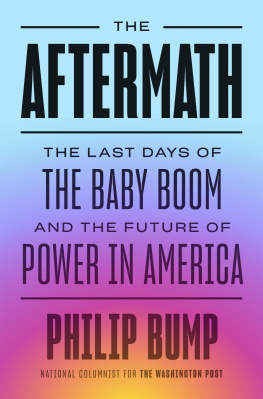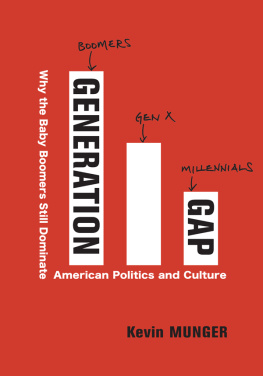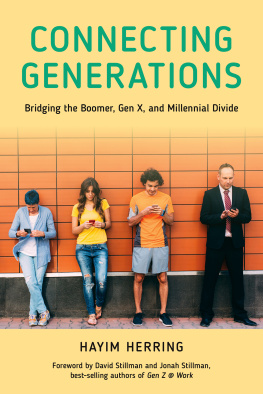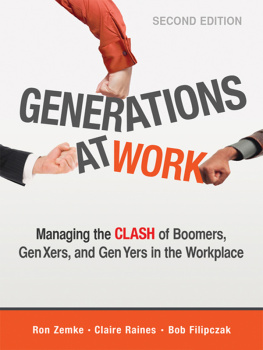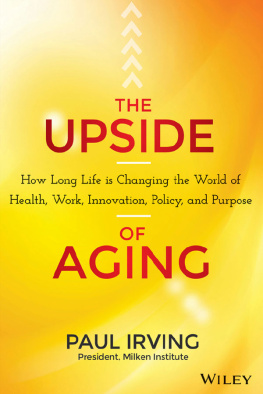Thank you for downloading this
AMACOM eBook.
Sign up for our newsletter, AMACOM BookAlert, and
receive special offers, access to free samples,
and info on the latest new releases from AMACOM,
the book publishing division of
American Management Association.
To sign up, visit our website: www.amacombooks.org

UP SIDE
UP SIDE
Profiting from the Profound
Demographic Shifts Ahead
KENNETH W. GRONBACH
WITH M. J. MOYE

CONTENTS
Foreword
I HAVE SPENT A good part of four decades studying and relying upon demographics. For some, the use of population trends and statistics is the stuff (or perhaps the stuffy) of cocktail parties and testy holiday dinner conversation. But for those of us who make forecasts and guide our clients through the turbulent waters of disruptive change, demographics provide the tools, the content, the baseline, and the trend lines to buttress our peek into the future.
Our capacity to collect statistical data continues to grow by leaps and bounds, and with breathtaking speed. We are well into the world of Big Datamind-blowingly large amounts of data that can be analyzed to reveal patterns, trends, etc., about all sorts of human behavior. We even wear it in the form of Fit Bits, heat and cool our rooms in the form of smart thermostats, swipe our credit cards when we make purchases or draw from our accounts, and track it in the form of Google Analytics.
Do we need this information? Yes, resoundingly, of course. And we need the people who know how to look at it, read it, ask the right questions of it, make some good sense of it, and finally point us in the direction of that which we as humans all seek answers towhat will our future look like? Where are the opportunities to improve our lives? What are the pitfalls and obstacles to avoid? Those who can help us answer these questions can give us the edge financially, open possible doors to growth, or offer our children a better chance.
Ken Gronbach is among the best at reading and finding meaning from demographicsand seeing into the future. We once spoke at a conference in a lovely spot in Minnesota and I was mesmerized by his aplomb in discussing potential opportunities in the numbers where others less talented might see only concerns. He also has the very rare ability to entertaindemographics can indeed be fun.
Upside is a very important contribution for anyone who could benefit from a peek into the future.
John Zogby is the founder of the Zogby Poll, senior partner at John Zogby Strategies, and author of three books on the future, most recently We Are Many, We are One: Neo-Tribes and Tribal Analytics in 21st Century America.
Introduction
WHEREVER PEOPLE ARE, they are always making a demographic impact. Whether a population is large or small, people always leave their mark. I believe that the science and art of demographics is grossly underrated and unappreciated. It is a simple science, really, that deals with live births, fertility, immigration, migration, aging, and death. This book was written to demonstrate the enormous power of counting people, promote the understanding of population change through time, and show how distinct population groups and shifts in population size significantly impact the world around them.
While the impacts of shifting and changing demography are global, the eye of the perfect demographic storm is in the continent of North America in general and in the United States in particular.
Immigrants will continue to pour into the country and enhance and complement the U.S. population at a rate of about 1 million per year. Our fertility remains above replacement level, and we are having enough childrenabout 4 million per yearto sustain the country for future generations. The members of the largest generation in U.S. history, Generation Y, are moving out of their parents homes, entering the workforce, setting up households, marrying, and having children. One-third of the U.S. population of 320 million or socomposed of about 40 million African Americans, 55 million Hispanics, and 17 million Asianswill benefit socioeconomically from a new and honest diversity. The largest generation ever to retire in the United States will do just that, as Baby Boomers will retire at the rate of about 4 million per year. This will create new markets, cause a drop in unemployment, and dramatically boost the economy of the Southern and Western Sun Belt states. It is all good!
There is more. While the demographic climate of the United States looks especially good, the demographic-based outlook for much of the rest of the world is bleak. The labor forces of the European Union, Eastern Europe, and all of Asia will be decimated by poor fertility. A country that does not have babies cannot expect to maintain its numbers of adult workers, consumers, and taxpayers over the course of twenty to thirty years. The net result will be a steady flow of manufacturing back to the United States to take advantage of the best labor force in U.S. history.
This book is about finding the potential upside opportunities borne by changing demographics. While in many cases demographic change tends to be gradual, sometimes change comes on much more quickly. In both cases, though, recognizing the potential upside can be difficult.
Generally speaking, potential upside opportunities are more prevalent with growing population shifts than they are with declining populations shifts. And, as with the above-referenced population change in general, it is also difficult to foresee the potential downside caused by population declines.
I sometimes refer to growing population shifts that represent potential upside as tsunamis and often refer to declining population shifts that represent potential downside as sinkholes. The former represents a counterintuitive metaphor because I am seeking positive results from it. Nevertheless, tsunami perfectly describes the power of large growing shifts in population: These shifts are immensely powerful, hard to see, and incredibly challenging because the power is not really recognized until, like a tsunami, the shift actually hits. Just think of Americas Baby Boomers, who, as you will read in the pages ahead, have collectively acted like a tsunami as theyve aged through all the key epochs of life. And now, as they enter the retirement years, as by far the largest such cohort to ever retire, they will sweep over all things related to retirement like a tsunamian upside tsunami.
Interestingly, people knew that this Boomer retirement tsunami was coming, but for the most part America heard a warning siren that sounded way too early and has been looking out to sea ever since in a vain effort to mark its approach prior to making preparations. Well, the tsunami is hitting the shoreline, but were still not ready for it.
While perhaps more apt as a metaphor for the purposes of this book, referring to demographic changes related to population decline as sinkholes makes perfect sense as they are also immensely
So, for the purposes of this book, when you read about a demographic tsunami it will almost always represent a potential upside, and when you read about a demographic sinkhole I am more likely than not warning you about potential downside. But remember, forewarned is forearmed, and upside opportunity can sometimes be discovered on the cusp of potential downside. Or, to put it another way, tsunamis and sinkholes both create immense challenges, but while tsunamis definitely provide more potential upside opportunity, sinkholes can provide upside opportunities as well. Read on to learn about this fascinating sciencesome would say artcalled demography, understand its incredible power, and learn how to discover potential upside in demographic tsunamis and sinkholes before they strike, or bury you.


